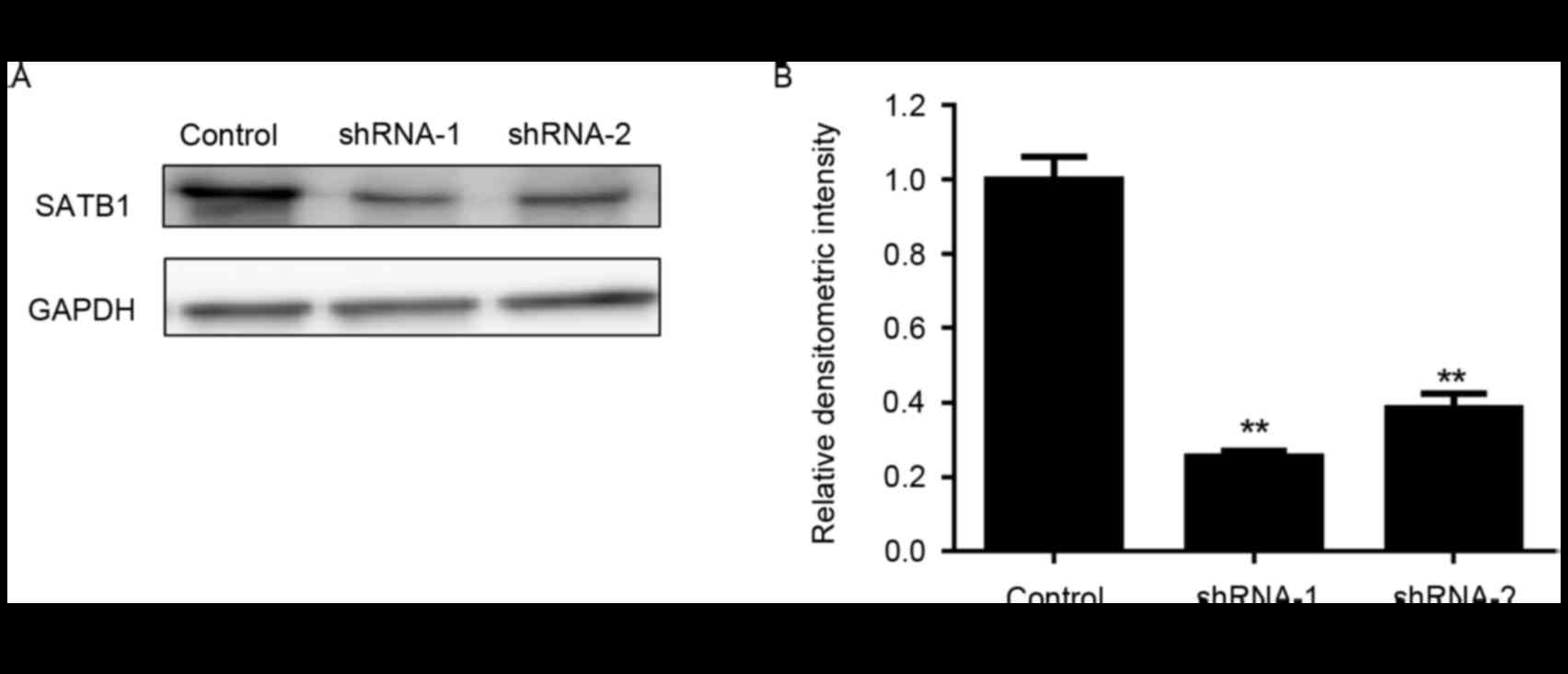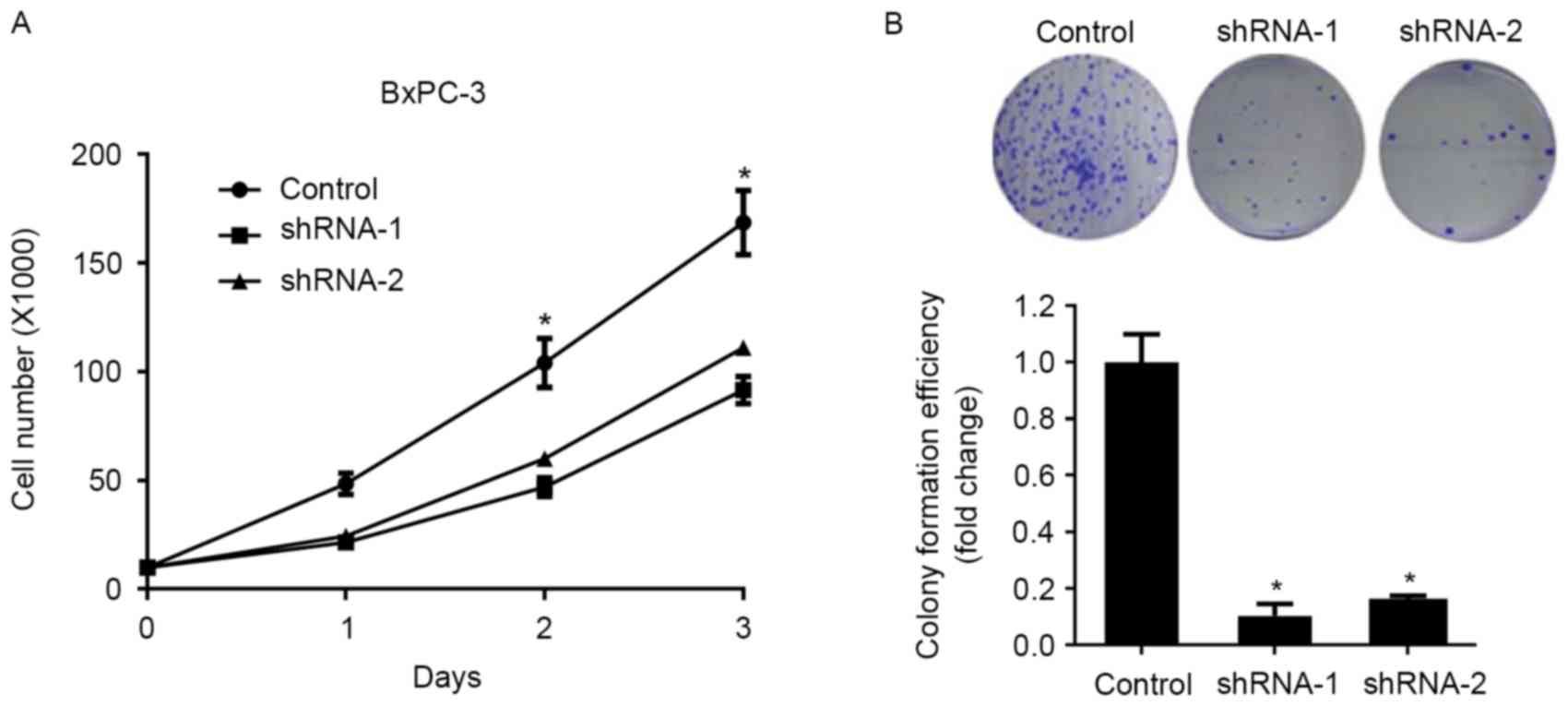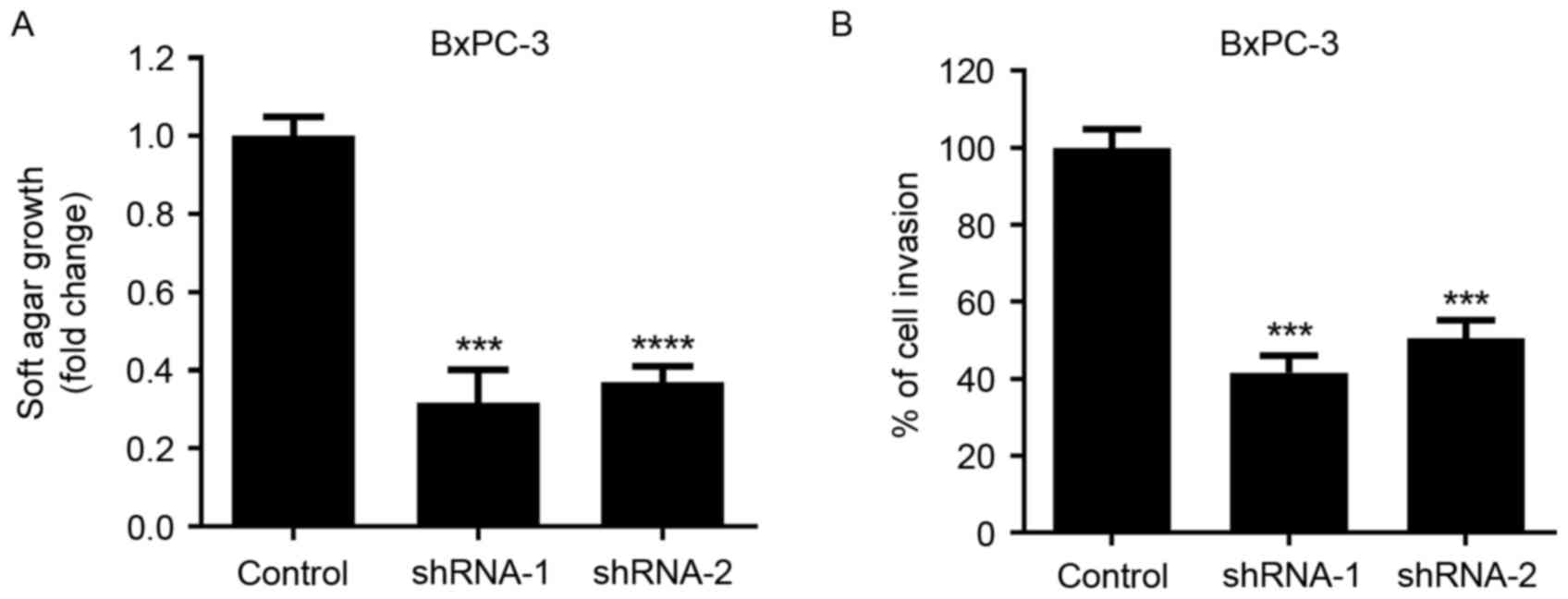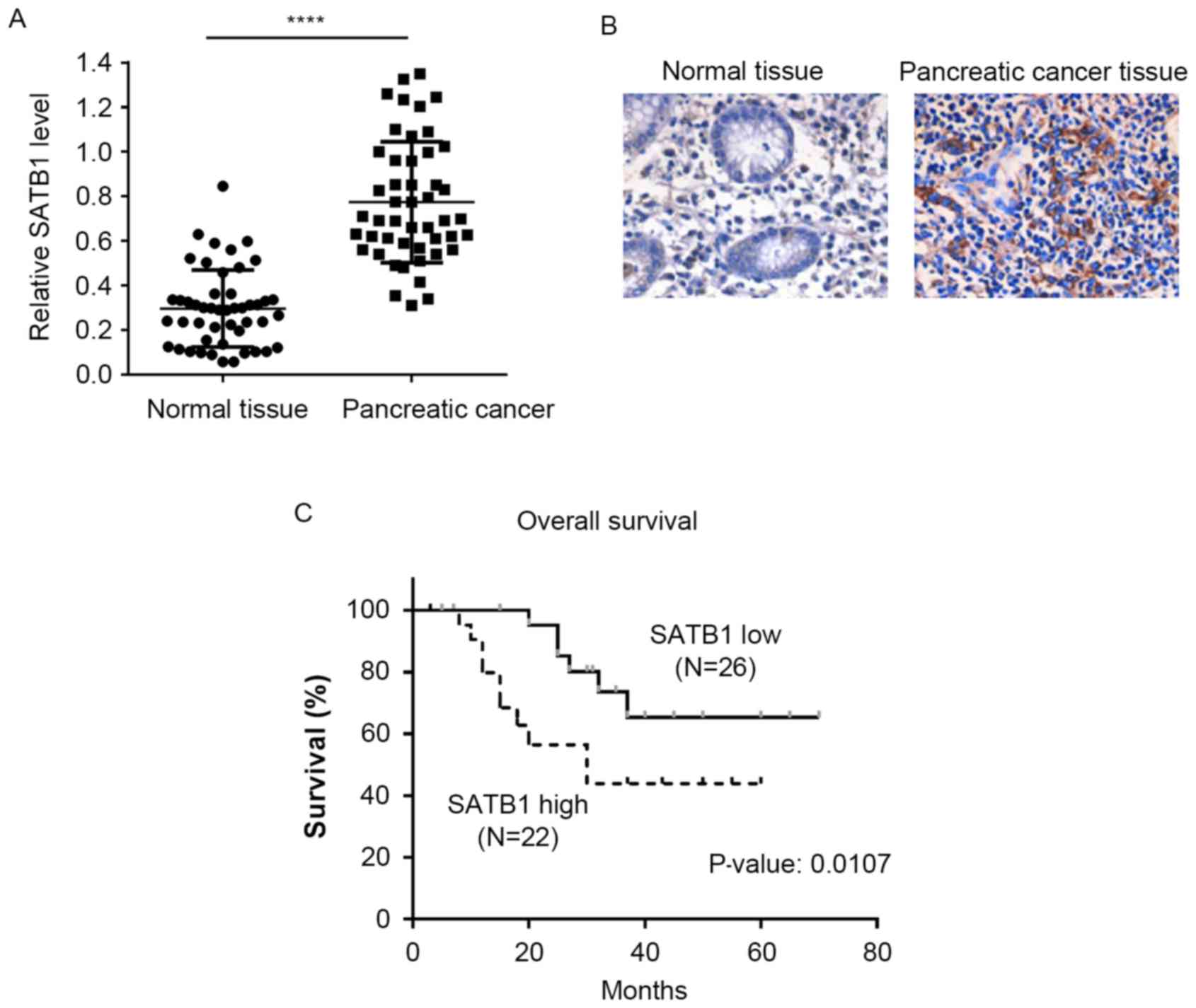Elevated expression of SATB1 is involved in pancreatic tumorigenesis and is associated with poor patient survival
- Authors:
- Published online on: October 2, 2017 https://doi.org/10.3892/mmr.2017.7683
- Pages: 8842-8848
-
Copyright: © Guo et al. This is an open access article distributed under the terms of Creative Commons Attribution License.
Abstract
Introduction
Pancreatic cancer is one of the most common causes of malignancy-associated morbidities and mortalities worldwide (1). Despite recent developments in surgical treatments and the efficacy of chemotherapeutic agents, the overall prognosis for patients with advanced pancreatic cancer remains poor, whereas the survival rate has not improved in the past few decades. This may be attributed to the asymptomatic nature of pancreatic cancer until the advanced stages of the disease, which constitutes a challenge for early diagnosis (2). The 5-year overall survival rate for patients with advanced pancreatic cancer is <10% (1). In China, the 5-year survival rate in patients with pancreatic cancer is 4.1% and the median survival time is limited to 3.9 months (3). Therefore, the need to identify novel prognostic biomarkers for the detection of pancreatic cancer at an early stage is of primary concern.
The special AT-rich sequence-binding protein 1 (SATB1) is a nuclear matrix-associated protein which is involved in higher-order chromatin organization and in the regulation of tissue-specific gene expression (4,5). SATB1 is primarily expressed in thymocytes and facilitates thymocyte development through its interaction with the Wnt-β-catenin signaling pathway (5,6). SATB1 has been associated with the development of several types of cancer, including glioma, colorectal, breast, lung and kidney cancers (7–11). Various genes that are regulated by SATB1 have been implicated in carcinogenesis, including erbB-2, Abelson murine leukemia viral oncogene homolog 1, matrix metalloproteinase 2, E-cadherin, vascular endothelial growth factor B, transforming growth factor-β1 and kisspeptin (12,13). In addition, upregulation of SATB1 expression has been associated with unfavorable clinicopathological features and poor patient survival (8,10,14), whereas SATB1 depletion has been reported to suppress the proliferation, growth and invasion of breast cancer cells, through the modulation of gene expression (15). Furthermore, silencing of SATB1 expression has been demonstrated to prevent tumor growth and metastasis, whereas transduction of SATB1 into non-metastatic cells promotes tumor invasion in mice (16). However, the effects of SATB1 on the development and progression of pancreatic cancer have yet to be elucidated.
In the present study, the effects of SATB1 downregulation on pancreatic cancer cell proliferation and tumorigenic properties were investigated in vitro and in vivo. In addition, the expression levels of SATB1 in tumor tissue samples from patients with pancreatic cancer were detected and association with patient survival was investigated.
Materials and methods
Cell culture and treatment
The human BxPC-3 pancreatic adenocarcinoma cell line was purchased from American Type Culture Collection (Manassas, VA, USA). Cells were cultured in Dulbecco's modified Eagle's medium (DMEM; Thermo Fisher Scientific, Inc., Waltham, MA, USA) supplemented with 10% fetal bovine serum (FBS; Thermo Fisher Scientific, Inc.), and maintained at 37°C in a 5% CO2 atmosphere.
Patient samples
The present study was approved by the Institutional Research Ethics Committee of the People's Hospital of Xinjiang (Urumqi, China). Written informed consent was obtained from patients prior to enrollment in the present study. A total of 48 patients who were admitted in People's Hospital of Xinjiang between 2013 and 2015 were included in the present study. Patient characteristics are presented in Table I. Patients were diagnosed with pancreatic cancer based on histopathological examination. No patients received chemotherapy or radiotherapy prior to surgery. Cancer tissue and adjacent normal tissue (distance >10 cm from the primary tumor) samples were isolated from patients who underwent tumor resection, and were immediately frozen in liquid nitrogen and stored at −80°C. Tissue samples were fixed in 10% neutral-buffered formalin at room temperature for 24 h. Following fixation, tissue samples were dehydrated by immersion in increasing concentrations of alcohol. Alcohol was cleared with xylene and tissues were embedded in paraffin by heating to 60°C and allowed to harden at room temperature overnight.
Lentiviral transduction and stable colony selection
For the production of the lentivirus, 1 µg control short hairpin (sh)RNA (cat no. sc-108060; Santa Cruz Biotechnology, Inc., Dallas, TX, USA) or SATB1-targeting shRNAs (cat no. sc-36460; Santa Cruz Biotechnology, Inc.) were co-transfected with 1 µg packaging plasmids (0.4 µg pMD2G and 0.6 µg psPAX2; Santa Cruz Biotechnology, Inc.) into human 293FT cells (80% confluent) in DMEM supplemented with 10% FBS, using Effectene transfection reagent (Qiagen, Inc., Valencia, CA, USA) according to the manufacturer's protocol. Lentiviral supernatants were collected 48 h post-transfection and filtered through a 0.45 µm filter to remove debris. BxPC-3 cells cultured in DMEM supplemented with 10% FBS (80% confluent) were transduced at room temperature with 500 µl of viral supernatants at a multiplicity of infection of 10, containing 4 µg/ml Polybrene transfection reagent (Sigma-Aldrich; Merck KGaA, Darmstadt, Germany) for 18 h, and resistant colonies were selected with 2 µg/ml puromycin (Sigma-Aldrich; Merck KGaA) for 7 days. Successful transduction was confirmed by western blotting. Control cells were transduced with control shRNA.
Western blot analysis
Total proteins were extracted from 200,000 BxPC-3 cells following shRNA transduction, using Laemmli SDS reducing buffer (50 mM Tris-HCl pH 6.8, 2% SDS and 10% glycerol) at 4°C, boiled and quantified using a bicinchoninic acid protein assay. Equal amounts (30 µg) of extracted protein samples were resolved by 8–10% PAGE and transferred onto polyvinylidene difluoride membranes. The membranes were blocked with 3% milk at room temperature for 1 h, incubated with primary antibodies against SATB1 (cat no. ab92307; 1:1,000; Abcam, Cambridge, UK) and GAPDH (cat no. 2118; 1:2,000; Cell Signaling Technology, Inc., Danvers, MA, USA) for 1 h at room temperature, followed by incubation with horseradish peroxidase-conjugated goat anti-rabbit secondary antibody (cat no. sc-2030, Santa Cruz Biotechnology, Inc.) at a dilution of 1:5,000 at room temperature for 1 h. Protein bands were visualized by enhanced chemiluminescence using the SuperSignal West Pico or Femto Chemiluminescent Substrate kits (Thermo Fisher Scientific, Inc.). Blots were semi-quantified using ImageJ software version 1.41 (National Institutes of Health, Bethesda, MD, USA) (17).
Cell proliferation assay
BxPC-3 cells stably expressing control shRNA or SATB1 shRNA were seeded in DMEM supplemented with 10% FBS at a density of 10,000 cells/well in 6-well plates in triplicate on day 0. Cells were trypsinized and counted using a TC20 Automated Cell Counter (Bio-Rad Laboratories, Inc., Hercules, CA, USA) on days 0, 1, 2 and 3. Each experiment was performed twice using cells from different suspensions.
Colony formation assay
BxPC-3 cells stably expressing control shRNA or SATB1 shRNA were seeded in 6-well plates at a density of 1,000 cells/well and cultured in DMEM supplemented with 10% FBS at 37°C. Cells were cultured for 1 week and then washed three times with PBS, fixed in 4% paraformaldehyde for 15 min, and stained with 0.1% crystal violet for 30 min at room temperature. Subsequently, the colonies (diameter, >1 mm) were carefully washed with PBS until the background was clear and visualized under an optical microscope. Colony formation efficiency was calculated as the number of colonies divided by 1,000 and normalized to control shRNA infected cells using ImageJ software verson 1.41.
Soft agar assay
BxPC-3 cells (1,000 cells) stably expressing control shRNA or SATB1 shRNA were suspended in 0.375% Noble agar (Difco; BD Biosciences, Franklin Lakes, NJ, USA) in DMEM supplemented with 10% FBS and overlaid on 0.75% Noble agar in 24-well plates. Colonies were allowed to grow for 7–10 days in the growth medium. Colony formation efficiency was calculated according to the following formula: Colony formation efficiency=(mean number of colonies/well)/(number of seeded cells/well). Colonies with a diameter >0.1 mm were measured and counted, and the mean was used. Data was expressed as fold-change compared to cells expressing the control vector. GraphPad Prism software version 5 (GraphPad Software, Inc., La Jolla, CA, USA) was used for analysis.
Matrigel invasion assay
A total of 105 BxPC-3 cells stably expressing control shRNA or SATB1 shRNA were serum-starved overnight, suspended in DMEM and plated into the upper chambers of 8.0-µm pore Transwell inserts which were coated with 400 µg/ml Matrigel (BD Biosciences). A total of 500 µl medium supplemented with 10% FBS was added to the lower chambers as a chemoattractant. Cells were incubated at 37°C for 24 h. Non-migrated cells on the top of the membrane were removed using cotton swabs, and cells that had migrated to the lower membrane were stained with 6% glutaraldehyde/0.5% crystal violet solution at room temperature for 30 min. Experiments were performed in triplicate. Invaded cells were visualized under an optical microscope, and counted using ImageJ software (17), by averaging the number of stained cells/field of view in 5 random fields/chamber.
IHC
Paraffin-embedded tumor and adjacent normal 5-µm thick tissue sections were subjected to antigen retrieval by heating in a microwave at 100°C for 10 min in 0.1 M citric acid buffer (pH 6.0), deparaffinized in xylene and rehydrated in graded ethanol. Endogenous peroxidase activity was blocked with 3% hydrogen peroxide for 1 h at room temperature, following permeabilization with ice-cold 100% methanol for 10 min at −20°C and rinsed in PBS for 5 min. Sections were then incubated with an anti-SATB1 antibody (1:200; cat no. ab92307; Abcam) at 4°C overnight. Following incubation with HRP-conjugated secondary antibodies (cat no. BA-1000; 1:200; Vector Laboratories, Inc., Burlingame, CA, USA) at room temperature for 1 h, the slides were developed in 0.05% 3,3′-diaminobenzidine (Vector Laboratories, Inc.) containing 0.01% hydrogen peroxide at room temperature for 1 min. As a negative control, sections were incubated with normal goat serum (Invitrogen; Thermo Fisher Scientific, Inc.), instead of primary antibodies, at 4°C overnight. The density of the staining was ranked as follows: 0, no staining; 1, mild staining; 2, moderate staining; and 3, intense staining. The extent of staining was scored as follows: 0, no positive cells; 1, positive cells cover <10% of total area; 2, positive cells cover 10–50% of total area; and 3, positive cells cover >50% of total area. The final staining score was obtained by multiplying the intensity score with the extent score. The samples were classified into 2 groups according to the final score: Low (0–4) and high (5–9).
Mouse xenografts
Animal experiments were approved by the Institutional Animal Care and Use Committee of the National Cancer Center (Urumqi, China). BXPC-3 cells expressing control shRNA or SATB1 shRNA (3×106 cells/injection) were subcutaneously injected into both flanks of 10 female nude mice (age, 6 weeks; weight, ~25 g). The mice were purchased from the Chinese University of Hong Kong (Hong Kong, China) and maintained in individually ventilated cages under a 12-h light/dark cycle at 20–22°C and 40–60% relative humidity with free access to food and water. Between days 8 to 26 post-implantation, tumor volumes were measured using a caliper according to the following formula: Tumor volume (mm3)=tumor length × (tumor width)2/2]. Data were expressed as the mean tumor volume ± standard deviation. Mice were sacrificed 26 days post-implantation by CO2 inhalation.
RNA isolation and reverse transcription-quantitative polymerase chain reaction (RT-qPCR)
Total RNA was extracted from cancer tissue and paired normal mucosal tissue samples isolated from 48 patients with pancreatic cancer using TRIzol® (Invitrogen; Thermo Fisher Scientific, Inc.), according to the manufacturer's protocol. Total RNA (1 µg) was reverse transcribed into cDNA using RevertAid™ First Strand cDNA Synthesis kit (Thermo Fisher Scientific, Inc.). The reaction volume was 20 µl and contained 1 µg RNA and 1 µl dT primer, 4 µl reaction buffer, 2 µl dNTP, 0.5 µl inhibitor and 0.5 µl reverse transcriptase. The temperature protocol was as follows: At 65°C for 10 min, at 25°C for 10 min, at 55°C for 30 min, and then at 85°C for 5 min. PCR was performed on cDNA using a ViiA™ 7 Real-Time PCR system (Applied Biosystems; Thermo Fisher Scientific, Inc.) with SYBR® Premix DimerEraser™ (Takara Bio, Inc., Otsu, Japan) according to the manufacturer's protocol. Each experiment was performed in triplicate. Primer sequences were as follows: SABT1, forward 5′-AAAAGAAATCGGACCACCAAGC-3′, reverse 5′-TGTGGTACGGAGCTGATCG-3′; and GAPDH, forward 5′-GGCCAAGGTCATCCATGACAA-3′ and reverse 5′-TCTTCTGACACCTACCGGGGA-3′. Thermocycling conditions were as follows: Initial denaturation at 95°C for 2 min, followed by 40 cycles at 95°C for 10 sec, and at 60°C for 30 sec, with an extension at 72°C for 30 sec. The specificity of the amplification products was confirmed by the exhibition of a singlet in the melting curve and gene expression was quantified according to the comparative Cq method (18).
Statistical analysis
Data are expressed as the mean ± standard deviation of 3 independent experiments. Data were analyzed using one-way analysis of variance (ANOVA) or mixed-factorial ANOVA, where appropriate. Multiple comparisons were then further investigated using Tukey post hoc test. P<0.05 was considered to indicate a statistically significant difference. Survival curves were constructed using the Kaplan-Meier method and compared using log-rank test. Statistical analyses were performed using SPSS software version 16 (SPSS, Inc., Chicago, IL, USA) and GraphPad Prism software version 5.0 (GraphPad Software, Inc., La Jolla, CA, USA).
Results
SATB1 knockdown inhibits the proliferation and suppresses the clonogenicity of pancreatic cancer cells
To examine the functions of SATB1 on pancreatic cancer cell growth, stable SATB1-knockdown BxPC-3 cells were established using RNA interference. As presented in Fig. 1, following transduction with 2 independent shRNAs targeting SATB1, the protein expression levels of SATB1 in BxPC-3 cells were significantly downregulated. Knockdown of SATB1 expression significantly inhibited the proliferation of BxPC-3 cells compared with control cells, as demonstrated by a cellular proliferation assay (Fig. 2A). In addition, BxPC-3 cells transduced with SATB1-specific shRNAs exhibited significantly suppressed colony formation capabilities (Fig. 2B), thus suggesting that SATB1 may enhance the proliferation and clonogenicity of pancreatic cancer cells.
SATB1 knockdown suppresses the anchorage-independent growth and invasion of pancreatic cancer cells
Soft agar growth and Matrigel invasion assays were performed to evaluate the effects of SATB1 knockdown on the tumorigenic properties of pancreatic cancer cells. As presented in Fig. 3, following the downregulation of SATB1 expression, the anchorage-independent growth of BxPC-3 cells was significantly inhibited. In addition, the invasive capabilities of cancer cells were significantly reduced following SATB1 shRNA transduction, as demonstrated by the Matrigel invasion assay.
SATB1 knockdown inhibits tumor growth in a pancreatic cancer xenograft mouse model
To investigate the effects of SATB1 on pancreatic cancer cell growth in vivo, a mouse xenograft model was established following the subcutaneous injection of BxPC-3 cells expressing control shRNA or SATB1 shRNA-1 into nude mice. Tumor growth was monitored for 26 days post-xenotransplantation. As demonstrated in Fig. 4, SATB1 downregulation significantly reduced the weight and growth rate of tumor xenografts in vivo. These findings suggested that SATB1 may serve a role in promoting tumor growth in vivo.
SATB1 expression is upregulated in pancreatic cancer tissues and is associated with poor prognosis
Pancreatic cancer tissue and matched non-cancerous adjacent tissue samples were isolated from 48 patients with pancreatic cancer. Semi-quantitative RT-PCR demonstrated that the mRNA expression levels of SATB1 were significantly upregulated in pancreatic cancer tissues compared with in matched control samples (Fig. 5A). In addition, IHC results revealed that pancreatic cancer tissues exhibited stronger SATB1 staining compared with non-cancerous tissue samples (Fig. 5B). The patient cohort was divided into low and high SATB1 expression groups according to the IHC scoring, and a Kaplan-Meier survival analysis was performed. As presented in Fig. 5C, patients with high SATB1 expression had significantly shorter overall survival times compared with patients with low SATB1 expression scores.
Discussion
Pancreatic cancer is one of the most malignant types of cancer, and is characterized by a high incidence of metastasis and a low 5-year survival rate. Platinum-based antineoplastic drugs or paclitaxel combination chemotherapy are the standard regimens used for the treatment of pancreatic cancer; however, the recurrence rate of the disease remains as high as 85% (2) Therefore, the need to identify novel therapeutic targets for the treatment of pancreatic cancer is of primary concern.
SATB1 has been suggested to regulate gene expression by selectively tethering far-distal specialized DNA sequences to its cage-like network, and scaffolding them with chromatin-modifying and transcription factors in order to accurately modulate gene expression (19,20). Previous studies have reported that SATB1 is overexpressed in metastatic breast cancer cell lines and in tissue specimens isolated from patients with metastatic breast carcinoma (21,22). Depletion of SATB1 has been demonstrated to suppress cancer cell growth and inhibit tumor metastasis, whereas its overexpression promotes tumor growth and lung colonization in breast cancer (15). A previous study reported that transient silencing of SATB1 expression inhibits the proliferation and invasion of small cell lung cancer cells (23). However, the effects of SATB1 downregulation on pancreatic cancer tumorigenesis have yet to be elucidated.
In the present study, stable downregulation of SATB1 expression using RNA interference significantly inhibited the proliferative, colony formation and invasive capabilities of BxPC-3 cells, and suppressed soft agar growth. In addition, SATB1 knockdown repressed tumor growth in a xenograft mouse model. SATB1 may be implicated in pancreatic tumorigenesis through the regulation of several genes known to be involved in carcinogenesis; however, further studies are required to investigate the molecular mechanisms and downstream effectors of SATB1 that are involved in the development of pancreatic cancer. Pan et al (24) reported that high SATB1 expression is significantly correlated with the progression and metastasis of breast cancer, and thus with poor disease prognosis. Similarly, in the present study, SATB1 expression was revealed to be significantly upregulated in pancreatic cancer tissues compared with in matched non-cancerous adjacent tissues. Notably, Kaplan-Meier survival analysis revealed that high SATB1 expression was significantly associated with decreased patient survival, thus suggesting that SATB1 may have potential as a prognostic biomarker for patients with pancreatic cancer.
In conclusion, the results of the present study suggested that SATB1 may be implicated in pancreatic tumorigenesis. SATB1 was revealed to be significantly upregulated in pancreatic cancer tissues and was associated with poor survival of patients with pancreatic cancer. Therefore, SATB1 may have potential as a novel therapeutic target for the treatment of patients with pancreatic cancer, and as a biomarker for disease prognosis. However, further studies are required to fully elucidate the molecular mechanisms that underlie the implication of SATB1 in promoting pancreatic cancer progression.
Acknowledgements
The present study was supported by the People's Hospital of Xinjiang, Urumqi, China (grant no. 829020801).
References
|
Siegel RL, Miller KD and Jemal A: Cancer statistics, 2016. CA Cancer J Clin. 66:7–30. 2016. View Article : Google Scholar : PubMed/NCBI | |
|
Kaur S, Baine MJ, Jain M, Sasson AR and Batra SK: Early diagnosis of pancreatic cancer: Challenges and new developments. Biomark Med. 6:597–612. 2012. View Article : Google Scholar : PubMed/NCBI | |
|
Luo J, Xiao L, Wu C, Zheng Y and Zhao N: The incidence and survival rate of population-based pancreatic cancer patients: Shanghai cancer registry 2004–2009. PLoS One. 8:e760522013. View Article : Google Scholar : PubMed/NCBI | |
|
Nakayama Y, Mian IS, Kohwi-Shigematsu T and Ogawa T: A nuclear targeting determinant for SATB1, a genome organizer in the T cell lineage. Cell Cycle. 4:1099–1106. 2005. View Article : Google Scholar : PubMed/NCBI | |
|
Cai S, Han HJ and Kohwi-Shigematsu T: Tissue-specific nuclear architecture and gene expression regulated by SATB1. Nat Genet. 34:42–51. 2003. View Article : Google Scholar : PubMed/NCBI | |
|
Notani D, Gottimukkala KP, Jayani RS, Limaye AS, Damle MV, Mehta S, Purbey PK, Joseph J and Galande S: Global regulator SATB1 recruits beta-catenin and regulates T(H)2 differentiation in Wnt-dependent manner. PLoS Biol. 8:e10002962010. View Article : Google Scholar : PubMed/NCBI | |
|
Nodin B, Johannesson H, Wangefjord S, O'Connor DP, Lindquist KE, Uhlén M, Jirström K and Eberhard J: Molecular correlates and prognostic significance of SATB1 expression in colorectal cancer. Diagn Pathol. 7:1152012. View Article : Google Scholar : PubMed/NCBI | |
|
Zheng J: Is SATB1 a master regulator in breast cancer growth and metastasis? Womens Health (Lond). 4:329–332. 2008. View Article : Google Scholar : PubMed/NCBI | |
|
Selinger CI, Cooper WA, Al-Sohaily S, Mladenova DN, Pangon L, Kennedy CW, McCaughan BC, Stirzaker C and Kohonen-Corish MR: Loss of special AT-rich binding protein 1 expression is a marker of poor survival in lung cancer. J Thorac Oncol. 6:1179–1189. 2011. View Article : Google Scholar : PubMed/NCBI | |
|
Chu SH, Ma YB, Feng DF, Zhang H, Zhu ZA, Li ZQ and Jiang PC: Upregulation of SATB1 is associated with the development and progression of glioma. J Transl Med. 10:1492012. View Article : Google Scholar : PubMed/NCBI | |
|
Cheng C, Wan F, Liu L, Zeng F, Xing S, Wu X, Chen X and Zhu Z: Overexpression of SATB1 is associated with biologic behavior in human renal cell carcinoma. PLoS One. 9:e974062014. View Article : Google Scholar : PubMed/NCBI | |
|
Kohwi-Shigematsu T, Poterlowicz K, Ordinario E, Han HJ, Botchkarev VA and Kohwi Y: Genome organizing function of SATB1 in tumor progression. Semin Cancer Biol. 23:72–79. 2013. View Article : Google Scholar : PubMed/NCBI | |
|
Mir R, Pradhan SJ and Galande S: Chromatin organizer SATB1 as a novel molecular target for cancer therapy. Semin Cancer Biol. 13:1603–1615. 2012. | |
|
Deng YF, Zhou DN, Pan ZY and Yin P: Aberrant SATB1 expression is associated with Epstein-Barr virus infection, metastasis and survival in human nasopharyngeal cells and endemic nasopharyngeal carcinoma. Int J Clin Exp Pathol. 7:2454–2461. 2014.PubMed/NCBI | |
|
Han HJ, Russo J, Kohwi Y and Kohwi-Shigematsu T: SATB1 reprogrammes gene expression to promote breast tumour growth and metastasis. Nature. 452:187–193. 2008. View Article : Google Scholar : PubMed/NCBI | |
|
Neznanov N, Kohwi-Shigematsu T and Oshima RG: Contrasting effects of the SATB1 core nuclear matrix attachment region and flanking sequences of the keratin 18 gene in transgenic mice. Mol Biol Cell. 7:541–552. 1996. View Article : Google Scholar : PubMed/NCBI | |
|
Schneider CA, Rasband WS and Eliceiri KW: NIH Image to ImageJ: 25 years of image analysis. Nat Methods. 9:671–675. 2012. View Article : Google Scholar : PubMed/NCBI | |
|
Livak KJ and Schmittgen TD: Analysis of relative gene expression data using real-time quantitative PCR and the 2(-Delta Delta C(T)) method. Methods. 25:402–408. 2001. View Article : Google Scholar : PubMed/NCBI | |
|
Cai S, Lee CC and Kohwi-Shigematsu T: SATB1 packages densely looped, transcriptionally active chromatin for coordinated expression of cytokine genes. Nat Genet. 38:1278–1288. 2006. View Article : Google Scholar : PubMed/NCBI | |
|
Yamaguchi H, Tateno M and Yamasaki K: Solution structure and DNA-binding mode of the matrix attachment region-binding domain of the transcription factor SATB1 that regulates the T-cell maturation. J Biol Chem. 281:5319–5327. 2006. View Article : Google Scholar : PubMed/NCBI | |
|
Hanker LC, Karn T, Mavrova-Risteska L, Ruckhäberle E, Gaetje R, Holtrich U, Kaufmann M, Rody A and Wiegratz I: SATB1 gene expression and breast cancer prognosis. Breast. 20:309–313. 2011. View Article : Google Scholar : PubMed/NCBI | |
|
Patani N, Jiang W, Mansel R, Newbold R and Mokbel K: The mRNA expression of SATB1 and SATB2 in human breast cancer. Cancer Cell Int. 9:182009. View Article : Google Scholar : PubMed/NCBI | |
|
Huang B, Zhou H, Wang X and Liu Z: Silencing SATB1 with siRNA inhibits the proliferation and invasion of small cell lung cancer cells. Cancer Cell Int. 13:82013. View Article : Google Scholar : PubMed/NCBI | |
|
Pan Z, Jing W, He K, Zhang L and Long X: SATB1 is correlated with progression and metastasis of breast cancers: A meta-analysis. Cell Physiol Biochem. 38:1975–1983. 2016. View Article : Google Scholar : PubMed/NCBI |














